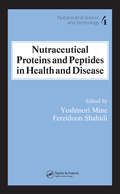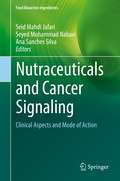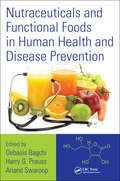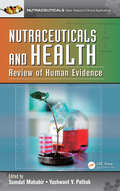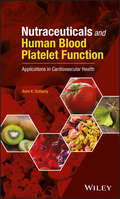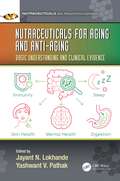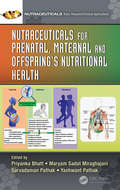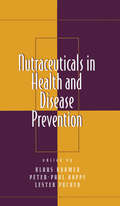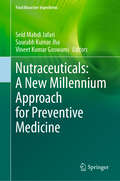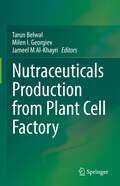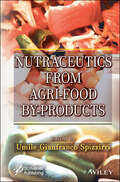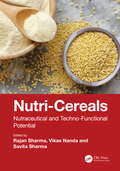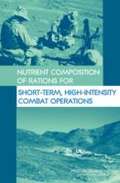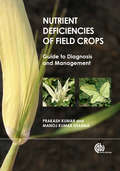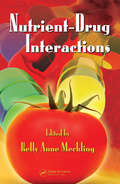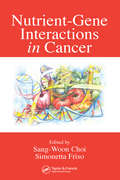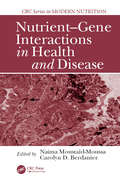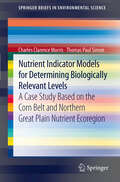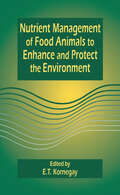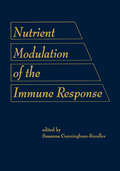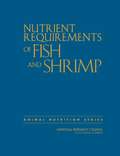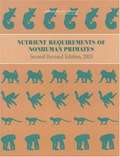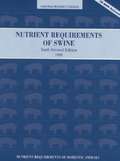- Table View
- List View
Nutraceutical Proteins and Peptides in Health and Disease (Nutraceutical Science and Technology)
by Yoshinori Mine Fereidoon ShahidiReports of the beneficial health effects of some peptides have begun to make their way into the scientific literature. Peptides can act as immunomodulators, and have been shown to have a positive influence on calcium absorption, and on regulation of serum cholesterol. A number of peptides may also possess antimicrobial properties that enhance the b
Nutraceuticals and Cancer Signaling: Clinical Aspects and Mode of Action (Food Bioactive Ingredients)
by Seid Mahdi Jafari Seyed Mohammad Nabavi Ana Sanches SilvaToday's consumers are looking for food products with health-promoting roles in addition to nutritional benefits. With current research showing that nutraceuticals and functional foods rich in specific bioactives may have chemopreventative effects, these products are increasingly popular. However, while much in the literature supports the health-promoting features of these foods, few texts focus on their bioactive agents and their mode of action in cancer signaling. Nutraceuticals and Cancer Signalling: Clinical Aspects and Mode of Action explains the link between nutraceuticals and cancer in terms of clinical trials and modes of action. This book gives an overview of common cancers and their mechanisms, and the most common functional foods and their bioactive components. Individual chapters focus on specific functional foods--including tomatoes, garlic, honey, tea, yoghurt, and many more--their prominent bioactive compounds, and their mode of action in cancer signaling and chemoprevention. Recent findings on cancer-prevention roles of different vitamins and minerals are also discussed. For food scientists, nutritionists, and pharmaceutical experts looking to understand how functional foods can play a role in fighting cancer, this text serves as a one-stop reference.
Nutraceuticals and Functional Foods in Human Health and Disease Prevention
by Debasis Bagchi Harry G. Preuss Anand SwaroopFunctional foods and nutraceuticals, dietary supplements, and natural antioxidants have established their potential roles in the protection of human health against disease. Nutraceuticals and Functional Foods in Human Health and Disease Prevention examines the benefits, efficacy, and success of properly designed nutraceuticals and functional foods
Nutraceuticals and Health: Review of Human Evidence (Nutraceuticals)
by Somdat Mahabir Yashwant V. PathakAlthough health claims for nutraceuticals range from the fantastic to the sublime, most of these claims are based on cell culture studies and have not been validated in humans, making them inadequate for public health recommendations. Focusing on human population-based research (epidemiology studies), Nutraceuticals and Health: Review of Human Evid
Nutraceuticals and Human Blood Platelet Function: Applications in Cardiovascular Health
by Asim K. DuttaroyA comprehensive review of the impact of dietary nutraceuticals on platelet function and its relationship to cardiovascular disease Nutraceuticals and Human Blood Platelet Function offers a summary of the most current evidence on the effects of anti-platelet factors isolated mainly from food and natural sources, their structure function relationship, bioavailability, mechanisms of actions, and also information on human trials data. The author—a noted expert in the field— explores platelet function and their roles in development of CVD, functional foods and bioactive compounds in CVD risk factors. The author highlights platelets, their mechanisms of actions, data from epidemiological studies, structure-function relationship clinical trial data, ex vivo and in vitro data. This important resource will focus primarily on human studies and emphasize functional and physiological implications of the nutritional impact on platelet function and CVD that could be an important approach to highlight the concept of preventive CVD nutrition. An authoritative text, Nutraceuticals and Human Blood Platelet Function: Offers a unique resource that connects nutrition with platelet function and its impact on cardiovascular disease Contains an evidenced-based approach, including data from human and animal clinical studies Reveals the impact of bioactive compounds and their effect on platelets Presents a text that is authored by an expert with vast experience in the field of nutrition and platelet function Written for professionals, academics, researchers, and students associated in the area of nutrition, Nutraceuticals and Human Blood Platelet Function offers a review of the most current research on the effects of platelet function and their roles in development of CVD, functional foods and bioactive compounds in CVD risk factors.
Nutraceuticals for Aging and Anti-Aging: Basic Understanding and Clinical Evidence (Nutraceuticals)
by Jayant Nemchand LokhandeAging can be perceived differently during different times in one’s life. Aging as a process not only influences medical and economic dimensions at an individual level but also at societal and national levels. Aging is a natural process; however, its standard definition in a healthcare context is yet unclear. To delay the aging process and to maintain quality of life until the end of life are two goals of prime importance. Various healthcare approaches are being developed and experimented on to best manage aging as if it is a disease. Nutraceuticals are value-added dietary supplement products and have an immense potential in altering key structures and functions of aging. Nutraceuticals can be a keystone in altering sub-normal performing physiological and metabolic systems due to aging. Nutraceuticals for Aging and Anti-Aging: Basic Understanding and Clinical Evidence addresses aging and anti-aging nutraceuticals based on 10 major challenges, such as cognitive health, malnutrition, substance abuse, bladder control, and oral health, among others. It examines how these challenges can be complemented with nutraceuticals and connects the applications with the traditional wisdom of the aging process. Key Features Examines the aging process, then recommends nutraceuticals for aging and anti-aging processes Describes the aging process from the western perspective, and Ayurvedic medicine (Indian traditional system) and traditional Chinese medicine perspectives Provides, whenever possible, the clinical evidence of the applications of nutraceuticals for aging and anti-aging This book is a valuable resource for physicians, clinical experts, pharmaceutical companies and their experts, nutrition specialists, entrepreneurs, chemists, pharmacists, food chemists-technologists, as well as researchers and post-graduate students involved in these specialties.Also available in the Nutraceuticals: Basic Research/Clinical Applications Series:Bioactive Peptides: Production, Bioavailability, Health Potential, and Regulatory Issues, edited by John O. Onuh, M. Selvamuthukumaran, and Yashwant V. Pathak (ISBN: 978-0-3675-1177-7)Nutraceuticals for Prenatal, Maternal and Offspring’s Nutritional Health, edited by Priyanka Bhatt, Maryam Sadat Miraghajani, Sarvadaman Pathak, and Yashwant V. Pathak (ISBN 978-1-1383-4582-9)Advances in Nutraceutical Applications in Cancer: Recent Research Trends and Clinical Applications, edited by Sheeba Varghese Gupta, and Yashwant V. Pathak (ISBN 978-1-1385-9391-6)
Nutraceuticals for Prenatal, Maternal, and Offspring’s Nutritional Health (Nutraceuticals)
by Priyanka Bhatt Maryam Sadat Miraghajani Sarvadaman Pathak Yashwant PathakAlthough there is an increasing number of pregnant individuals taking nutraceuticals to maintain good health, many gaps exist in the knowledge base. These nutraceuticals might be involved in a wide variety of biological processes, and the biological and epidemiological findings of relevant studies should be examined and analyzed. Nutraceuticals for Prenatal, Maternal and Offspring’s Nutritional Health focuses on the role of nutraceuticals for prenatal, mothers, and offspring’s health. In recent years, new trends have been established in this area of prenatal nutrition, that is, mother and offspring health based on appropriate nutrition during pre-pregnancy, pregnancy, and after pregnancy. Nutraceuticals and natural products have been used by many cultures and societies around the world. This book focuses on recent trends and potential clinical evaluations of such nutraceuticals and natural products. Features: Examines the role of Nutraceuticals on the mothers and offspring’s disease and health Focuses on human population-based research Discuses role of nutraceuticals in placental development, nutraceuticals for gestational weight pain and post-partum obesity Covers nutraceuticals impacting uterine growth, gestational age, and mortality rate Explores the question whether Nutraceuticals intake in pregnant women is safe as they might be involved a wide variety of biological processes With 19 chapters written by established lead authors in this field, Nutraceuticals for Prenatal, Maternal and Offspring’s Nutritional Health addresses important findings of the latest scientific research regarding the role of nutraceuticals intake before and during pregnancy.
Nutraceuticals in Health and Disease Prevention
by Lester Packer Klaus KrÄmer Peter-Paul HoppePromoting scientific support for the plethora of health benefits related to nutrition and medicine, Nutraceuticals in Health and Disease Prevention delivers a comprehensive and scientifically sound overview of the latest research findings in disease prevention, therapy, and enhanced body function in the revolutionary field of nutraceutical technolo
Nutraceuticals: A New Millennium Approach for Preventive Medicine (Food Bioactive Ingredients)
by Seid Mahdi Jafari Saurabh Kumar Jha Vineet Kumar GoswamiNutraceuticals are defined as any food bioactive compounds or supplements which provide health and medicinal benefits, usually in the prevention of disease and sometimes playing a role in their treatment as well. Nutraceuticals are a combination of a variety of nutrients ranging from vitamins and minerals to certain amino acids. Nutrients are an essential part of the diet and serve a variety of roles in human physiology through various enzymes which govern biocatalysis in various metabolic pathways including tissue and DNA repair and body defense and immunity. Nutrients that are routinely prescribed as dietary supplements include multivitamins, minerals and certain specific amino acids. Nutraceuticals not only serve a pivotal role in tissue repair and body defense mechanism but also play a crucial role in various signal transduction and metabolic pathways. The deficiency of any crucial nutrient can negatively affect metabolic and transduction pathways which can lead toa variety of diseases and disorders. The preventive use of nutraceuticals is a promising new trend for a variety of diseases and disorders. Nutraceuticals: A New Millennium Approach for Preventive Medicine focuses on the preventive use of nutraceuticals to avoid various diseases and disorders. The chapters cover nutrients and human physiology, metabolism and xenobiotics, plus their use in the prevention and treatment of a wide range of diseases and disorders from cancer to cardiovascular disorders to diabetes and renal diseases. Further chapters study the role nutraceuticals play in the treatment of depression and mental illnesses, neurogenerative diseases and autoimmune diseases. The relationship between nutrients and suboptimal health is explored as are links between nutrition and infertility. As these food supplements continue to gain in popularity with consumers, it is increasingly important to understand their benefits and limitations in the prevention and treatment of various diseases and disorders, and this book offers a fully up-to-date snapshot for researchers.
Nutraceuticals Production from Plant Cell Factory
by Tarun Belwal Milen I. Georgiev Jameel M Al-KhayriThis book focuses on in vitro techniques and challenges of producing nutraceutical compounds from plant cells. In addition, it provides an overview of different biosynthesis pathways and their modulation through cell culture techniques for the production of nutraceutical compounds in high quantity and quality. It also includes the assessment of the factors influencing production and advances in cell culture techniques, including the scale-up approach using bioreactors. Lastly it provides valuable suggestion for future research.
Nutraceutics from Agri-Food By-Products
by Umile Gianfranco SpizzirriNUTRACEUTICS FROM AGRI-FOOD BY-PRODUCTS This book represents a comprehensive and unique overview covering different aspects (raw materials, technological innovations, and potential applications) concerning waste and by-products of the food industry. Wastes and by-products of the agri-food chain represent a rich source of active molecules that can be usefully employed in the food and pharmaceutical industries. Eco-friendly extraction procedures able to isolate the different components of the agri-food by-products represent an attractive challenge to increase the waste’s value, and, at the same time, solve the issues usually related to their disposal. Each of the 12 chapters in Nutraceutics from Agri-Food By-Products deeply analyses a specific agri-food chain, highlighting the main components recovered in the processing of food, seafood, and dairy wastes and by-products. Specifically, a green approach to the extraction of active molecules is described, as well as the industrial application of agri-food wastes and by-products, and their chemical, physical, and biological properties. Such properties are suitable for use in the food, cosmetic, and pharmaceutical fields. This circular approach could be usefully employed in the industry to develop and commercialize new nutraceuticals and/or functional food that guarantee a considerable increase in the economic worth of the wastes, while producing beneficial effects on human health. Audience Food technologists and biotechnologists in research and industry as well as researchers in pharmaceutical sciences.
Nutri-Cereals: Nutraceutical and Techno-Functional Potential
by Rajan Sharma Vikas Nanda Savita SharmaThe term "Nutri-Cereals" has been dedicated to ten cereals due to their unique nutritional benefits. Nutri-Cereals: Nutraceutical and Techno-Functional Potential covers these cereal grains, with each chapter focusing on nutrient composition and bioactive characterization followed by associated bio-functional properties and health benefits. Further, it covers techno-functionality of nutri-cereals including rheological properties, emulsification and foaming potential, gelation behavior, color profile and others which dictate the suitability of cereals in finished products. Key Features: Covers diverse biological and functional features of nutri-cereals to dictate their potential as functional ingredients in value-added products. Discusses the nutraceutical potential of ten cereals: sorghum, pearl millet, finger millet, foxtail millet, barnyard millet, kodo millet, little millet, proso millet, black wheat and Amaranthus. Explains how these grains are ideal ingredients for gluten free food formulations with enhanced bio- and techno-functional characteristics. Although many of the nutri-cereals have been known for thousands of years, due to their coarse nature and lack of processing they escaped the human diet. Now, thanks to their excellent agro-economic potential and numerous health benefits, they are once again recognized as functional ingredients. Recently, earmarked investment and funding have been observed for valorization of these crops and thus, this book will help academicians to strengthen future investigations.
Nutrient Composition Of Rations For Short-term, High-intensity Combat Operations
by National Research Council of the National AcademiesRecognizing the importance of good nutrition for physical and mental status, the Department of Defense asked the Institute of Medicine to guide the design of the nutritional composition of a ration for soldiers on short-term, high-stress missions. Nutrient Composition of Rations for Short-Term, High-Intensity Combat Operations considers military performance, health concerns, food intake, energy expenditure, physical exercise, and food technology issues. The success of military operations depends to a large extent on the physical and mental status of the individuals involved. Appropriate nutrition during assault missions is a continuous challenge mainly due to diminished appetites of individuals under stress. Many less controllable and unpredictable factors, such as individual preferences and climate, come into play to reduce appetite. In fact, soldiers usually consume about half of the calories needed, leaving them in a state called “negative energy balance.” The consequences of being in negative energy balance while under these circumstances range from weight loss to fatigue to mental impairments. An individual’s physiological and nutritional status can markedly affect one’s ability to maximize performance during missions and may compromise effectiveness. With the number of these missions increasing, the optimization of rations has become a high priority.
Nutrient Deficiencies of Field Crops: Guide to Diagnosis and Management
by Prakash Kumar Manoj Kumar SharmaNutrient imbalance in soils is an emerging threat to sustainable agriculture: intensive cultivation, use of poor quality groundwater, depletion of soil organic matter and excessive use of fertilizers are major reasons for poor soil fertility worldwide. This necessitates correct diagnosis of plant nutrient deficiencies to avoid further use of pesticides in cases where pests or pathogens that are not in fact the cause of poor crop health. Richly illustrated with 600 colour photographs, this book is a visual field identification guide for symptoms of most common nutrient deficiencies in field crops, covering all their stages of occurrence. Detailed descriptions and suggested for management practices are given with each entry.
Nutrient Deficiencies of Field Crops
by Manoj Kumar Sharma Prakash KumarNutrient imbalance in soils is an emerging threat to sustainable agriculture: intensive cultivation, use of poor quality groundwater, depletion of soil organic matter and excessive use of fertilizers are major reasons for poor soil fertility worldwide. This necessitates correct diagnosis of plant nutrient deficiencies to avoid further use of pesticides in cases where pests or pathogens that are not in fact the cause of poor crop health. Richly illustrated with 600 colour photographs, this book is a visual field identification guide for symptoms of most common nutrient deficiencies in field crops, covering all their stages of occurrence. Detailed descriptions and suggested for management practices are given with each entry.
Nutrient-Drug Interactions
by Kelly Anne MecklingCurrent research has given us a more complete understanding of how the chemicals in foods and herbs interact with natural and synthetic drugs. In some cases a single food or supplement can profoundly increase or decrease the toxicity and/or efficacy of a single drug. Although it is standard practice to examine the effects of food consumption on the
Nutrient-Gene Interactions in Cancer
by Sang-Woon Choi Simonetta FrisoThe complete mapping of the human genome, along with the development of sophisticated molecular technologies, has accelerated research on the relationship between nutrients and genes. This has led to compelling evidence garnered from epidemiological and experimental observations supporting the idea that the interaction between nutrients and genes i
Nutrient-Gene Interactions in Health and Disease
by Carolyn D. Berdanier Naima Moustaid-MoussaWe have come to realize that optimal nutrient intake is determined by very specific genetic messages. This realization has led to an entirely new approach to understanding nutrition - the exploration of nutrient effects on gene expression. Edited by leading experts in the field, Nutrient-Gene Interactions in Health and Disease provides an
Nutrient Indicator Models for Determining Biologically Relevant Levels
by Charles Clarence Morris Thomas Paul SimonNutrient Indicator Models for Determining Biologically Relevant Levels: A case study based on the Corn Belt and Northern Great Plain Nutrient Ecoregion is the first book to provide answers to the management of nutrients based on changes in biological communities. The text describes a case study that is the result of a large scale project in the Corn Belt and Great Plains Nutrient Ecoregion. This study is the first to identify relationships between fish assemblages and nutrient concentrations by Nitrogen species. Species optima based on sensitivity and tolerance to nutrients is modeled. Nutrient Biotic indices calibrated for application are based on the results of years of biological indicator development. Test response intervals and Shift response intervals are formulated and validated against relevant biological assemblage shifts. This case study is the first to suggest recommended values for the nitrogen and phosphorus cycle with identifiable shifts caused in biological assemblages. This will provide watershed and environmental managers with the information needed to manage the inputs into the world's dead zones.
Nutrient Interactions
by C.E. BodwellThis book contains the proceedings of the Eleventh Annual Basic Symposium sponsored by the Institute of Food Technologists and the International Union of Food Science and Technology. It discusses nutrition interactions in human and emphasizes research findings from human and animal studies.
Nutrient Management of Food Animals to Enhance and Protect the Environment
by E.T. KornegayNutrient management is an important aspect of feeding livestock and poultry. Today, there is more attention directed toward this issue in animal production than ever before. The heightened awareness of the environmental impacts associated with animal production has caused animal nutritionists to refocus their thoughts, practices, and expectations regarding how nutrients are supplied to animals. In addition, the increase in the size and intensity of modern production units demands new technologies for enhancing nutrient utilization and for reducing the amount of nutrients excreted. Covering these issues and more, Nutrient Management of Food Animals to Enhance and Protect the Environment is a reference tool for agricultural industry leaders, private practitioners, governmental agencies, and researchers.
Nutrient Modulation of the Immune Response
by Susanna Cunningham-RundThis book demonstrates that nutrients play a direct role as co-factors and regulators of the immune system. The book also shows that modulating the immune response with nutrients can provide a fundamental approach to preventive medicine.;Containing nearly 2300 bibliographic citations as well as illustrative figures, tables, and micrographs, this book is designed to be of interest to clinical immunologists, immunology and vitamin researchers, nutrition specialists, paediatricians, neonatologists, and upper-level undergraduate, graduate, and medical school students in these disciplines.
Nutrient Requirements of Fish and Shrimp
by Committee on the Nutrient Requirements of Fish ShrimpAquaculture now supplies half of the seafood and fisheries products consumed worldwide and is gaining international significance as a source of food and income. Future demands for seafood and fisheries products can only be met by expanded aquaculture production. Such production will likely become more intensive and will depend increasingly on nutritious and efficient aquaculture feeds containing ingredients from sustainable sources. To meet this challenge, Nutrient Requirements of Fish and Shrimp provides a comprehensive summary of current knowledge about nutrient requirements of fish and shrimp and supporting nutritional science. This edition incorporates new material and significant updates to information in the 1993 edition. It also examines the practical aspects of feeding of fish and shrimp. Nutrient Requirements of Fish and Shrimp will be a key resource for everyone involved in aquaculture and for others responsible for the feeding and care of fish and shrimp. It will also aid scientists in developing new and improved approaches to satisfy the demands of the growing aquaculture industry.
Nutrient Requirements of Nonhuman Primates: Second Revised Edition, 2003
by Committee on Animal NutritionThis new release presents the wealth of information gleaned about nonhuman primates nutrition since the previous edition was published in 1978. With expanded coverage of natural dietary habits, gastrointestinal anatomy and physiology, and the nutrient needs of species that have been difficult to maintain in captivity, it explores the impact on nutrition of physiological and life-stage considerations: infancy, weaning, immune function, obesity, aging, and more. The committee also discusses issues of environmental enrichment such as opportunities for foraging.Based on the world's scientific literature and input from authoritative sources, the book provides best estimates of nutrient requirements. The volume covers requirements for energy: carbohydrates, including the role of dietary fiber; proteins and amino acids; fats and fatty acids; minerals, fat-soluble and water-soluble vitamins; and water. The book also analyzes the composition of important foods and feed ingredients and offers guidelines on feed processing and diet formulation.
Nutrient Requirements of Swine: Tenth Revised Edition, 1998
by Subcommittee on Swine NutritionThe tenth edition of this essential reference presents new knowledge about the nutritional needs of swine that consider such factors as growth rate, carcass leanness, gender, health, environment, and repartitioning agents. New sections are presented on requirements for amino acids and other nutrients. In addition, an original modeling approach to arriving at energy and amino acid needs for given animals is incorporated in this revision. The book comes with a CD-ROM that allows users to create tables of nutrient requirements for swine of a specific body weight and level of productivity. Nutrient Requirements of Swine covers: Biological concepts that underlie nutrient needs for growth and function. New data on amino acid and energy requirements and the factors that shape them. New findings on lysine and the bioavailability of amino acids. New research results on minerals and vitamins. Nutrient composition of an expanded list of feedstuffs. The role of water in swine physiology, including factors that affect the quality of drinking water. Expanded tables of feed ingredients and their nutrient composition provide bioavailability estimates, fatty acid composition of fats typically used in swine diets, and important information on estimating the amino acid content of crude protein.
